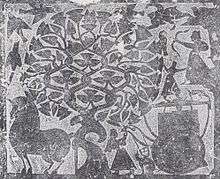Wu Family Shrines

Rubbing of a detail from the Wu family shrines' stone relief carvings. The scene depicts the Fusang tree, Xihe who is going to hitch her Dragon Horse to the Sun Chariot, and Archer Yi who takes aim at the Sun Crows.
The Wu Family Shrines (Chinese: 武氏祠; pinyin: wǔ shì cí), of which the Wu Liang Shrine is the best known, was the family shrine of the Wu clan of the Eastern Han dynasty. The shrines contain a vast amount of relief carvings.[1]
Three walls of Wu Liang's shrine were still standing as late as the 11th century, which is the reason that the site of all the family shrines are often called after him.[2] The shrine to Wu Liang (78-151 AD) was built in 151 AD in what is now southwestern Shandong province.[1]
References
- 1 2 Wu 1989, xvi-xix.
- ↑ "Rubbing of stone relief from the offering shrines of Wuliangci of the Han dynasty. Traditional grouping Wu Liang Group 3". Art Gallery of New South Wales. Retrieved 31 May 2017.
Literature
Hung, Wu (1989). The Wu Liang Shrine: The Ideology of Early Chinese Pictorial Art. Stanford: Stanford University Press. ISBN 9780804715294.
This article is issued from
Wikipedia.
The text is licensed under Creative Commons - Attribution - Sharealike.
Additional terms may apply for the media files.